Papers by Hermes Emilio Martínez Barrios
Power System Technology, 2024
The purpose of this review article is to address non-participant observation as a research techni... more The purpose of this review article is to address non-participant observation as a research technique, considering its characteristics, advantages and disadvantages. In addition, it seeks to offer a description of two variants of this methodology, as well as to provide recommendations for its design. The methodology employed in this text is framed within the parameters of the interpretive paradigm and uses the hermeneutic method to understand and interpret the arguments proposed by authors such as Weber
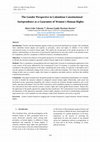
Letters in High Energy Physics, 2024
Introduction: Violence and discrimination against women are structural and historical scourges. T... more Introduction: Violence and discrimination against women are structural and historical scourges. The Colombian State establishes human dignity and equality as principles, values and rights. In addition, it has ratified international treaties on women's human rights. This implies the incorporation of the gender perspective in all spheres, understanding it as the process of assessing the implications for men and women of any planned action, be it legislation, policies or programs, in different scenarios, including the judicial. Objectives: To analyze the influence of the gender perspective in Colombian constitutional jurisprudence in order to identify the measures adopted to guarantee women's human rights in the Colombian context. Methods: This is a qualitative, jurisprudential and socio-legal study, focused on evaluating the application of law in the context of the issues addressed by the Constitutional Court of Colombia. It examines how legal norms contribute to the political purposes of the State, considering the social reality. Its objective is descriptive and it uses the analysis of emblematic rulings of the Court as a data collection technique. The criteria for selecting the rulings include cases on women's rights, their impact on legislation and public policies, and those that establish constitutional precedents. Conclusions: This paper examines how the gender perspective impacts constitutional jurisprudence in Colombia, in order to identify the measures adopted to safeguard women's human rights. Historically, male power has dominated society, generating inequalities and violence towards the feminine through institutions such as the family, education and religion. Since the 1991 Constitution, which establishes equality as a fundamental principle, laws and policies have been enacted to protect women's rights and combat gender-based violence. Despite this, the application of the gender approach by judges has been insufficient. The Constitutional Court has emphasized the importance of this approach to guarantee women's rights, playing a crucial role in transforming a patriarchal legal system into a more equitable one and seeking to impact both institutions and society in general.
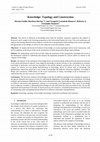
Letters in High Energy Physics, 2024
This article of reflection on knowledge arises from the academic experience acquired in the subje... more This article of reflection on knowledge arises from the academic experience acquired in the subjects of Research I and II, taught in the Sociology programme at the Universidad Popular del Cesar. This work synthesises and analyses the learning obtained in these subjects, with the aim of deepening the understanding of the various typologies and approaches to knowledge, as well as its role within the social and academic context. Objectives: To analyse the historical evolution of knowledge, its various typologies and its social construction, with special emphasis on the theory of the social construction of reality proposed by Berger and Luckmann. Method: The methodology used in this text falls within the parameters of the interpretative paradigm and resorts to the hermeneutic method to understand and interpret the arguments presented by various authors in relation to the category of knowledge. Results: The analysis of the typologies of knowledge shows an evolution deeply influenced by the interaction between social needs and historical contexts. From empirical knowledge in ancient societies to the consolidation of scientific knowledge in modernity, each type has responded to the specific demands and priorities of its time. In the current context, we observe an even greater diversification of knowledge, driven by factors such as technology and globalisation, which have given rise to new forms of knowledge and different criteria for validation. According to Berger and Luckmann's (1986) theory of the social construction of reality, knowledge in all its dimensions is a construction that can only occur in a social context. Conclusions: The historical evolution of knowledge reveals that its different typologies have emerged in response to the specific demands and contexts of each era, reflecting the adaptability of knowledge to social priorities. According to Berger and Luckmann's (1986) theory of the social construction of reality, knowledge acquires meaning as a function of collective interactions and agreements, making it an intrinsically social phenomenon. Thus, types of knowledge such as empirical, scientific or philosophical knowledge not only fulfil particular functions within society, but are also legitimised and transmitted on the basis of shared practices and consensus, consolidating themselves as essential tools for interpreting reality and guiding human behaviour in different communities and generations.
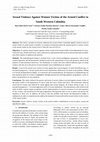
Letters in High Energy Physics, 2024
This article, a product of research, addresses the sexual violence committed against women in are... more This article, a product of research, addresses the sexual violence committed against women in areas of armed conflict in southwestern Colombia. It is based on testimonies about the attention given to women victims of the armed conflict by the Central Unit of Valle del Cauca (UCEVA). Objectives: To analyse sexual violence against women victims of the armed conflict in the departments of Cauca, Valle del Cauca, Nariño and Chocó, with a reflection on a phenomenon that has been silenced and made invisible, and which requires recognition and attention Methods: The methodological design is oriented from a socio-critical paradigmatic perspective, with a mixed research approach, and the hermeneutic method is used for the interpretation of texts and narratives, based on the analysis of semi-structured interviews. The testimonies of women who have suffered different types of sexual violence and who are in the process of post-traumatic stress rehabilitation are analysed Results: A total of 62 women were victims of crimes against their sexual integrity, of which 38 suffered rape, 11 unwanted pregnancies, 7 sexual assault and 6 sexual exploitations. Reflections are made on the problem, linking it to Sexual and Reproductive Rights. As conclusions and recommendations, the importance of implementing care and reparation plans for victims is highlighted, through psychosocial and legal guidance programmes, access to justice and guarantees of non-repetition. Conclusions: This study evidences the gravity and extent of sexual violence exercised against women victims of the armed conflict in the departments of Cauca, Valle del Cauca, Nariño and Chocó. The testimonies collected reveal that 62 women were affected by crimes against their sexual integrity, 38 of them victims of rape, 11 of unwanted pregnancies, 7 of sexual aggression and 6 of sexual exploitation. This phenomenon, often silenced and made invisible, requires urgent recognition and the implementation of concrete measures of care and reparation for the victims, with psychosocial and legal programmes that guarantee their access to justice and prevent the repetition of these acts. In addition, the need to link this problem with Sexual and Reproductive Rights is emphasised, in order to comprehensively address the situation of women affected by sexual violence in the context of the armed conflict.
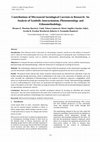
Letters in High Energy Physics, 2024
Introduction: This reflection article is the result of a documentary research, carried out in the... more Introduction: This reflection article is the result of a documentary research, carried out in the subjects of research I and II, within the Universidad popular del Cesar, this work had the purpose of studying the main contributions of the microsocial sociological currents, such as symbolic interactionism, phenomenology and ethnomethodology, to contemporary research. Objectives: To interpret the main contributions of micro-social sociological currents, such as symbolic interactionism, phenomenology and ethnomethodology, within the framework of contemporary sociological research. Methods: The methodology employed in this text is framed within the parameters of the interpretative paradigm and uses the hermeneutic method to understand and interpret the arguments proposed by the micro-social authors. Results: The general results indicate that, firstly, Symbolic Interactionism has identified how individuals create and modify meanings through interaction, which is fundamental to the study of the construction of identities and social roles. Secondly, the contribution of Phenomenology to the analysis of subjective experience is highlighted, which allows us to understand how people give meaning to their everyday experiences. Finally, Ethnomethodology highlights its role in understanding how social norms are maintained and negotiated in everyday life, thus contributing to the study of the implicit social order. These three sociological streams offer both theoretical and methodological arguments for approaching contemporary research. Conclusions: Microsocial currents have enriched sociological analysis by focusing on individual and everyday interactions. They have been fundamental to the study of the construction of social reality from the actors' perspective, and have provided qualitative methodologies that complement macro-social approaches.
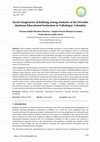
Review of Contemporary Philosophy, 2024
School bullying, commonly known as bullying, represents a social problem of great magnitude that ... more School bullying, commonly known as bullying, represents a social problem of great magnitude that negatively impacts educational communities worldwide. The social imaginaries that are constructed around this phenomenon have a decisive influence on the way students perceive and experience it. The present research was conducted under the interpretative paradigm and qualitative approach, using the ethnographic method to understand in depth the dynamics of this problem. Twenty semi-structured interviews were conducted with students from the Oswaldo Quintana Educational Institution, including 10 boys and girls, in addition to participant observation in six focus groups, with participants ranging in age from 10 to 18 years old.
Social imaginaries not only played a crucial role as a theoretical and methodological tool, but also allowed us to interpret the different dynamics of bullying within the school context, identifying different types of bullying: verbal, physical, social, cyber and sexual. Justifications for these practices were also detected, based on religious beliefs, physical characteristics, socio-economic level and academic performance of the affected students. It is crucial that the educational community, based on these social imaginaries, develop a deep understanding of the problem and focus on the creation of pedagogical and didactic strategies that promote values such as respect, empathy and inclusion. These actions should be aimed at building a safe and violence-free school environment, where a culture of healthy coexistence is fostered and discriminatory practices are minimised. The promotion of attitudes that favour an inclusive environment is vital to prevent and eradicate bullying in all its forms, protecting thewell-being of all students.
The purpose of this review article is to reflect on the state of the art as a methodological tool... more The purpose of this review article is to reflect on the state of the art as a methodological tool, describe its meaning, present its objectives, present notes for its elaboration, propose a structure and finally present an example of construction. The methodology of the text is oriented, from the parameters of the interpretive paradigm and the use of the hermeneutic method to understand and interpret the arguments proposed by Bojacá

This article is intended to determine compliance with the principle of solidarity in the accredit... more This article is intended to determine compliance with the principle of solidarity in the accreditation of the legal requirements to obtain the minimum pension guarantee in Colombia; The topic was addressed through a rigorous analysis of the theories and legal foundations of the topic of concern, as well as from the methodological approach directed from the interpretative paradigmatic view, the qualitative approach and the use of the methods of legal hermeneutics. yielding a thorough study of the requirements to obtain the minimum pension guarantee, where it was determined that the constitutional principle of solidarity is reflected in respect for compliance with these, granting within a maximum period of four months for the payment of the first pension allowance that guarantees a minimum subsistance wage and a development of life in dignified and fair conditions for workers who, during their working life, earned a current legal monthly minimum wage.
The purpose of this article is to reflect on urban social imaginaries as a theoretical and method... more The purpose of this article is to reflect on urban social imaginaries as a theoretical and methodological tool that allows interpreting social reality in the urban context. The methodology of the text is oriented from the parameters of the interpretive paradigm and the use of the hermeneutic method to understand the arguments proposed by Durkheim,
The purpose of this research article is to interpret security as an urban social imaginary linked... more The purpose of this research article is to interpret security as an urban social imaginary linked to the social relations of closed residential complexes in Valledupar. The methodology of the text is oriented from the parameters of the interpretive paradigm and the use of the ethnography method to understand the different texts, images, and interviews related to the research topic. The theoretical arguments are supported by the contributions proposed by
International Journal of Human Sciences Research, Oct 12, 2023
Sociólogo, investigador y docente de la universidad Popular del cesar, Magíster en: territorio, c... more Sociólogo, investigador y docente de la universidad Popular del cesar, Magíster en: territorio, conflicto y cultura. Doctor en lenguaje y cultura.
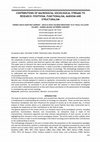
Russian Law Journal , 2022
Sociological schools of thought provide essential theoretical frameworks for understanding the co... more Sociological schools of thought provide essential theoretical frameworks for understanding the complexity of human societies. Each stream offers a different lens through which to examine the cultural, economic, political and historical aspects that shape individual and collective experiences. This paper aims to interpret the macro-social sociological currents, highlighting their characteristics, theories and most relevant representatives. It seeks to provide a comprehensive and reflective vision of these currents in order to understand their impact on sociology. The methodology employed in this text is framed within the parameters of the interpretative paradigm and uses the hermeneutic method to understand and interpret the arguments proposed by positivist, functionalist, Marxist and structuralist theorists.
In the findings and discussion, the principles of positivism and its influence on sociology were identified, Marxism was critically analysed in relation to capitalism, structuralism was examined for its focus on social structures and symbolic analysis, and functionalism was explored in terms of integration, stability and social functions. As conclusions it can be stated that the classical or macro-social sociological currents offer a detailed perspective on how each theory contributes to the advancement of knowledge in contemporary and current sociology.
FEAR AS AN URBAN SOCIAL IMAGINARY IN THE CLOSED RESIDENTIALCOMPLEXES IN THE CITY OF VALLEDUPAR, 2022
This scientific article aims to interpret fear as an urban social imaginary linked to relationshi... more This scientific article aims to interpret fear as an urban social imaginary linked to relationships in closed residential complexes in the city of Valledupar. The methodology is oriented, from the parameters of the qualitative approach, the use of the ethnographic method and the application of data collection techniques such as observation and semi-structured interviews, as well as the analysis of the arguments proposed by authors such
The purpose of this review article is to theoretically address observation as a research techniqu... more The purpose of this review article is to theoretically address observation as a research technique, considering its characteristics, advantages and disadvantages. In the same way, it is intended to describe the types of observations, present recommendations for the design of instruments for both participant and non-participant observation, and offer an example of design. The methodology used in this text is framed within the parameters of the interpretive paradigm and uses the hermeneutic method to understand and interpret the arguments proposed by authors such as Rosenthal and Jacobson (1968), Weber (1997), Mejía (2002), Fernández (2009). Campos and Lule (2010), Diaz (2011), Rekalde, Vizcarra and Macazaga (2014), Martínez-Cansola (2020), Rodríguez (2022) and others, who contribute to the understanding of the use of observation as a technique in scientific research.
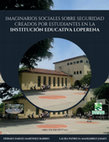
IMAGINARIOS SOCIALES SOBRE SEGURIDAD CREADOS POR ESTUDIANTES EN LA INSTITUCIÓN EDUCATIVA LOPERENA, 2023
En este texto titulado "Imaginarios Sociales sobre Seguridad creados por Estudiantes en la Instit... more En este texto titulado "Imaginarios Sociales sobre Seguridad creados por Estudiantes en la Institución Educativa Loperena", los autores Hermes Emilio Martínez Barrios y Laura Patricia Manajerrez Jaimes exploran las complejas dinámicas de percepción de seguridad entre los estudiantes de 10° y 11° grados. Este estudio se sitúa en el contexto urbano de Valledupar, Colombia, donde el Colegio Nacional Loperena sirve como microcosmos para entender cómo los jóvenes interpretan y experimentan la seguridad y la inseguridad en su entorno cotidiano.
La investigación se fundamenta en el paradigma interpretativo, utilizando un enfoque cualitativo y el método etnográfico para capturar la riqueza de las experiencias y percepciones de los estudiantes. Este enfoque permite adentrarse en el mundo subjetivo de los jóvenes, explorando no solo lo que ocurre objetivamente en términos de seguridad, sino también cómo se construyen y mantienen los imaginarios sociales en relación con la seguridad urbana.
Desde el inicio, los autores plantean una pregunta central: ¿Cuáles son los imaginarios sociales urbanos que los estudiantes del Colegio Nacional Loperena construyen en torno a los espacios de seguridad e inseguridad, tanto dentro de la institución como en sus alrededores? Esta pregunta guía un análisis exhaustivo de las percepciones, experiencias y narrativas de los estudiantes, revelando cómo las interacciones diarias, los encuentros con diferentes individuos y los espacios físicos contribuyen a formar sus percepciones de seguridad.
Los resultados del estudio son reveladores. Emergen patrones claros en la forma en que los estudiantes categorizan y asignan significados a los diversos espacios dentro y fuera de la escuela. Por ejemplo, áreas como los baños, la cafetería, la portería y las canchas deportivas dentro de la institución son identificadas como lugares de potencial riesgo, donde se reportan disturbios, peleas y conductas problemáticas. En contraste, espacios como los salones de clase, la rectoría, la biblioteca y los laboratorios son percibidos como seguros debido a la presencia de autoridades y la regulación constante.
Fuera del entorno escolar, las calles cercanas al colegio, plazas públicas como la plazoleta de la gobernación y la plaza Alfonso López, así como ciertos callejones y parques mal iluminados, son vistos como lugares donde pueden ocurrir incidentes de violencia, robos y consumo de drogas. En contraparte, zonas comerciales, bancos, supermercados y algunos barrios residenciales son considerados como seguros debido a la presencia visible de vigilancia privada, autoridades locales y una mayor actividad comunitaria.
Los imaginarios sociales que los estudiantes construyen no solo reflejan sus percepciones individuales de seguridad, sino que también están moldeados por las narrativas compartidas entre compañeros y la influencia de figuras de autoridad como profesores, celadores y policías. Estas percepciones, a su vez, impactan significativamente en cómo los jóvenes interactúan con su entorno urbano, influenciando sus decisiones sobre movilidad, interacción social y comportamientos preventivos.
Desde una perspectiva teórica, el libro se apoya en un corpus significativo de literatura sobre imaginarios sociales urbanos de seguridad, incluyendo trabajos de Durkheim (1982), Berger y Luckmann (1986), Castoriadis, (1983, 1989); Pinto (2004, 2005), Baeza Hernández y Valdivia, (2004 (2004), Pérez (2005), Guerrero, (2006), Carretero, (2011), Martínez I., (2011), Dittus (2011); Preciado (2011); Martínez, (2014); Santillán (2015); Jaramillo (2017); Segovia, Basulto y Zambrano, (2018), y otros autores contemporáneos que exploran cómo las representaciones simbólicas influyen en la experiencia urbana y en la configuración de la identidad social.
Este texto representa una valiosa contribución para comprender cómo los jóvenes elaboran y manejan sus percepciones de seguridad en un entorno urbano. No se limita a ser un mero estudio académico; ofrece ideas prácticas para mejorar la gestión educativa y comunitaria, señalando la importancia de abordar las preocupaciones de seguridad desde una perspectiva informada y sensible a las realidades locales.
Diseño del estado de arte: reflexiones, significado, objetivo, estructura y ejemplo , 2024
The purpose of this review article is to reflect on the state of the art as a methodological tool... more The purpose of this review article is to reflect on the state of the art as a methodological tool, describe its meaning, present its objectives, present notes for its elaboration, propose a structure and finally present an example of construction. The methodology of the text is oriented, from the parameters of the interpretive paradigm and the use of the hermeneutic method to understand and interpret the arguments proposed by Bojacá (2004), Jiménez (2006), Baeza (2008), Guevara (2016), Saldarriaga (2019), Duque (2021), Rivas (2023), among other authors, who conceptualize and theorize about the state of the art as a methodological instrument.
STATE OF THE ART DESIGN: REFLECTIONS, MEANING, OBJECTIVE, STRUCTURE AND EXAMPLE, 2024
Abstract – The purpose of this review article is to reflect on the state of the art as a methodol... more Abstract – The purpose of this review article is to reflect on the state of the art as a methodological tool, describe its meaning, present its objectives, present notes for its elaboration, propose a structure and finally present an example of construction. The methodology of the text is oriented, from the parameters of the interpretive paradigm and the use of the hermeneutic method to understand and interpret the arguments proposed by Bojacá (2004), Jiménez (2006), Baeza (2008), Guevara (2016), Saldarriaga (2019), Duque (2021), Rivas (2023), among other authors, who conceptualize and theorize about the state of the art as a methodological instrument.
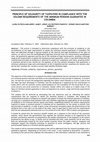
PRINCIPLE OF SOLIDARITY OF TAXPAYERS IN COMPLIANCE WITH THE SOLEMN REQUIREMENTS OF THE MINIMUM PENSION GUARANTEE IN COLOMBIA, 2024
This article is intended to determine compliance with the principle of solidarity in the accredit... more This article is intended to determine compliance with the principle of solidarity in the accreditation of the legal requirements to obtain the minimum pension guarantee in Colombia; The topic was addressed through a rigorous analysis of the theories and legal foundations of the topic of concern, as well as from the methodological approach directed from the interpretative paradigmatic view, the qualitative approach and the use of the methods of legal hermeneutics. yielding a thorough study of the requirements to obtain the minimum pension guarantee, where it was determined that the constitutional principle of solidarity is reflected in respect for compliance with these, granting within a maximum period of four months for the payment of the first pension allowance that guarantees a minimum subsistance wage and a development of life in dignified and fair conditions for workers who, during their working life, earned a current legal monthly minimum wage.
LEGERE IURIS Revista Programa de Derecho Universidad de Santander Sede Valledupar UDES, 2013
El presente artículo, está dedicado al análisis del conocimiento de manera general, donde se defi... more El presente artículo, está dedicado al análisis del conocimiento de manera general, donde se define la noción general del conocimiento, los tipos de conocimiento que han existido a través de la historia, se hace una disertación sobre el concepto de investigación científica como actividad y como proceso de búsqueda de nuevos conocimientos; teniendo en cuenta la descripción de categorías importantes como lo son: ciencia, investigación, metodología, teoría, técnica y finalmente se hacen reflexiones sobre el papel de la investigación en la universidad, con el que se busca informar a la comunidad académica sobre el funcionamiento de la investigación al interior de la Universidad, y la articulación con el SNCyT+I.









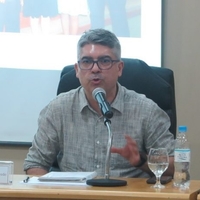

Uploads
Papers by Hermes Emilio Martínez Barrios
Social imaginaries not only played a crucial role as a theoretical and methodological tool, but also allowed us to interpret the different dynamics of bullying within the school context, identifying different types of bullying: verbal, physical, social, cyber and sexual. Justifications for these practices were also detected, based on religious beliefs, physical characteristics, socio-economic level and academic performance of the affected students. It is crucial that the educational community, based on these social imaginaries, develop a deep understanding of the problem and focus on the creation of pedagogical and didactic strategies that promote values such as respect, empathy and inclusion. These actions should be aimed at building a safe and violence-free school environment, where a culture of healthy coexistence is fostered and discriminatory practices are minimised. The promotion of attitudes that favour an inclusive environment is vital to prevent and eradicate bullying in all its forms, protecting thewell-being of all students.
In the findings and discussion, the principles of positivism and its influence on sociology were identified, Marxism was critically analysed in relation to capitalism, structuralism was examined for its focus on social structures and symbolic analysis, and functionalism was explored in terms of integration, stability and social functions. As conclusions it can be stated that the classical or macro-social sociological currents offer a detailed perspective on how each theory contributes to the advancement of knowledge in contemporary and current sociology.
La investigación se fundamenta en el paradigma interpretativo, utilizando un enfoque cualitativo y el método etnográfico para capturar la riqueza de las experiencias y percepciones de los estudiantes. Este enfoque permite adentrarse en el mundo subjetivo de los jóvenes, explorando no solo lo que ocurre objetivamente en términos de seguridad, sino también cómo se construyen y mantienen los imaginarios sociales en relación con la seguridad urbana.
Desde el inicio, los autores plantean una pregunta central: ¿Cuáles son los imaginarios sociales urbanos que los estudiantes del Colegio Nacional Loperena construyen en torno a los espacios de seguridad e inseguridad, tanto dentro de la institución como en sus alrededores? Esta pregunta guía un análisis exhaustivo de las percepciones, experiencias y narrativas de los estudiantes, revelando cómo las interacciones diarias, los encuentros con diferentes individuos y los espacios físicos contribuyen a formar sus percepciones de seguridad.
Los resultados del estudio son reveladores. Emergen patrones claros en la forma en que los estudiantes categorizan y asignan significados a los diversos espacios dentro y fuera de la escuela. Por ejemplo, áreas como los baños, la cafetería, la portería y las canchas deportivas dentro de la institución son identificadas como lugares de potencial riesgo, donde se reportan disturbios, peleas y conductas problemáticas. En contraste, espacios como los salones de clase, la rectoría, la biblioteca y los laboratorios son percibidos como seguros debido a la presencia de autoridades y la regulación constante.
Fuera del entorno escolar, las calles cercanas al colegio, plazas públicas como la plazoleta de la gobernación y la plaza Alfonso López, así como ciertos callejones y parques mal iluminados, son vistos como lugares donde pueden ocurrir incidentes de violencia, robos y consumo de drogas. En contraparte, zonas comerciales, bancos, supermercados y algunos barrios residenciales son considerados como seguros debido a la presencia visible de vigilancia privada, autoridades locales y una mayor actividad comunitaria.
Los imaginarios sociales que los estudiantes construyen no solo reflejan sus percepciones individuales de seguridad, sino que también están moldeados por las narrativas compartidas entre compañeros y la influencia de figuras de autoridad como profesores, celadores y policías. Estas percepciones, a su vez, impactan significativamente en cómo los jóvenes interactúan con su entorno urbano, influenciando sus decisiones sobre movilidad, interacción social y comportamientos preventivos.
Desde una perspectiva teórica, el libro se apoya en un corpus significativo de literatura sobre imaginarios sociales urbanos de seguridad, incluyendo trabajos de Durkheim (1982), Berger y Luckmann (1986), Castoriadis, (1983, 1989); Pinto (2004, 2005), Baeza Hernández y Valdivia, (2004 (2004), Pérez (2005), Guerrero, (2006), Carretero, (2011), Martínez I., (2011), Dittus (2011); Preciado (2011); Martínez, (2014); Santillán (2015); Jaramillo (2017); Segovia, Basulto y Zambrano, (2018), y otros autores contemporáneos que exploran cómo las representaciones simbólicas influyen en la experiencia urbana y en la configuración de la identidad social.
Este texto representa una valiosa contribución para comprender cómo los jóvenes elaboran y manejan sus percepciones de seguridad en un entorno urbano. No se limita a ser un mero estudio académico; ofrece ideas prácticas para mejorar la gestión educativa y comunitaria, señalando la importancia de abordar las preocupaciones de seguridad desde una perspectiva informada y sensible a las realidades locales.
Social imaginaries not only played a crucial role as a theoretical and methodological tool, but also allowed us to interpret the different dynamics of bullying within the school context, identifying different types of bullying: verbal, physical, social, cyber and sexual. Justifications for these practices were also detected, based on religious beliefs, physical characteristics, socio-economic level and academic performance of the affected students. It is crucial that the educational community, based on these social imaginaries, develop a deep understanding of the problem and focus on the creation of pedagogical and didactic strategies that promote values such as respect, empathy and inclusion. These actions should be aimed at building a safe and violence-free school environment, where a culture of healthy coexistence is fostered and discriminatory practices are minimised. The promotion of attitudes that favour an inclusive environment is vital to prevent and eradicate bullying in all its forms, protecting thewell-being of all students.
In the findings and discussion, the principles of positivism and its influence on sociology were identified, Marxism was critically analysed in relation to capitalism, structuralism was examined for its focus on social structures and symbolic analysis, and functionalism was explored in terms of integration, stability and social functions. As conclusions it can be stated that the classical or macro-social sociological currents offer a detailed perspective on how each theory contributes to the advancement of knowledge in contemporary and current sociology.
La investigación se fundamenta en el paradigma interpretativo, utilizando un enfoque cualitativo y el método etnográfico para capturar la riqueza de las experiencias y percepciones de los estudiantes. Este enfoque permite adentrarse en el mundo subjetivo de los jóvenes, explorando no solo lo que ocurre objetivamente en términos de seguridad, sino también cómo se construyen y mantienen los imaginarios sociales en relación con la seguridad urbana.
Desde el inicio, los autores plantean una pregunta central: ¿Cuáles son los imaginarios sociales urbanos que los estudiantes del Colegio Nacional Loperena construyen en torno a los espacios de seguridad e inseguridad, tanto dentro de la institución como en sus alrededores? Esta pregunta guía un análisis exhaustivo de las percepciones, experiencias y narrativas de los estudiantes, revelando cómo las interacciones diarias, los encuentros con diferentes individuos y los espacios físicos contribuyen a formar sus percepciones de seguridad.
Los resultados del estudio son reveladores. Emergen patrones claros en la forma en que los estudiantes categorizan y asignan significados a los diversos espacios dentro y fuera de la escuela. Por ejemplo, áreas como los baños, la cafetería, la portería y las canchas deportivas dentro de la institución son identificadas como lugares de potencial riesgo, donde se reportan disturbios, peleas y conductas problemáticas. En contraste, espacios como los salones de clase, la rectoría, la biblioteca y los laboratorios son percibidos como seguros debido a la presencia de autoridades y la regulación constante.
Fuera del entorno escolar, las calles cercanas al colegio, plazas públicas como la plazoleta de la gobernación y la plaza Alfonso López, así como ciertos callejones y parques mal iluminados, son vistos como lugares donde pueden ocurrir incidentes de violencia, robos y consumo de drogas. En contraparte, zonas comerciales, bancos, supermercados y algunos barrios residenciales son considerados como seguros debido a la presencia visible de vigilancia privada, autoridades locales y una mayor actividad comunitaria.
Los imaginarios sociales que los estudiantes construyen no solo reflejan sus percepciones individuales de seguridad, sino que también están moldeados por las narrativas compartidas entre compañeros y la influencia de figuras de autoridad como profesores, celadores y policías. Estas percepciones, a su vez, impactan significativamente en cómo los jóvenes interactúan con su entorno urbano, influenciando sus decisiones sobre movilidad, interacción social y comportamientos preventivos.
Desde una perspectiva teórica, el libro se apoya en un corpus significativo de literatura sobre imaginarios sociales urbanos de seguridad, incluyendo trabajos de Durkheim (1982), Berger y Luckmann (1986), Castoriadis, (1983, 1989); Pinto (2004, 2005), Baeza Hernández y Valdivia, (2004 (2004), Pérez (2005), Guerrero, (2006), Carretero, (2011), Martínez I., (2011), Dittus (2011); Preciado (2011); Martínez, (2014); Santillán (2015); Jaramillo (2017); Segovia, Basulto y Zambrano, (2018), y otros autores contemporáneos que exploran cómo las representaciones simbólicas influyen en la experiencia urbana y en la configuración de la identidad social.
Este texto representa una valiosa contribución para comprender cómo los jóvenes elaboran y manejan sus percepciones de seguridad en un entorno urbano. No se limita a ser un mero estudio académico; ofrece ideas prácticas para mejorar la gestión educativa y comunitaria, señalando la importancia de abordar las preocupaciones de seguridad desde una perspectiva informada y sensible a las realidades locales.